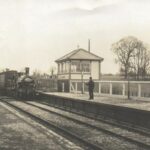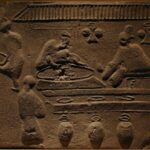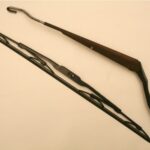As Wilbur Wright nervously watched his brother Orville take flight across the tall, sandy dunes of Kitty Hawk, N.C., he likely knew they were making history. But he probably could not have imagined what was to come of their success. He could have never dreamed that this brief but successful voyage would lead humans not only into flight but into space.
Of course, a lot of other exciting things happened in between the Wright Brothers’ first flight and our eventual trips to the moon, and we’re going to explore the history of the airplane so that we can better understand how we got to where we are today.
Recommended Reading
iPhone History: Every Generation in Timeline Order 2007 – 2023
Who Invented the Internet? The Origin and History of the Internet
The Complete History of Social Media: A Timeline of the Invention of Online Networking
Looking to the Sky
Humans had been fascinated with the sky and were dreaming of joining the birds long before the first legitimate attempts to fly were made. For example, as early as the 6th Century AD, prisoners in the northern Qi region of China were forced to take test flights on kites from a tower over the city walls.
Early attempts to fly were essentially attempts to mimic bird flight. Early designs were primitive and impractical, but over time, they became more complex. The first designs that resembled ‘flying machines’ were those produced by Leonardo Da Vinci in the late 15th Century, the most famous being the ‘flapping ornithopter’ and the ‘helical rotor.’
The Birth of Flight
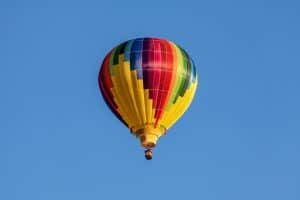
By the 17th century, the theory behind balloon flight had started to develop as Francesco Lana De Terzi began experimenting with pressure differentials. However, it wasn’t until the mid-18th century that the Montgolfier brothers developed larger models of the balloon. This led to the first manned hot air balloon flight (lighter than air) on November 21, 1783, by Jean-François Pilâtre de Rozier and Marquis d’Arlandes in Paris, France.
Not long after this, in 1799, Sir George Cayley of England developed the concept of the fixed-wing aircraft. He deduced that four forces acted on an aircraft that were ‘heavier than air.’ These four forces were:
- Weight – The force exerted on an object either through gravity or as a result of an external force applied to it.
- Lift – The upward part of the force that is applied to an object when the flow of air is directed towards it.
- Drag – The resistance against the forward motion of an object caused by the air movement and speed against it.
- Thrust – The force exerted against the direction of a moving object. This demonstrates Newton’s third law that the reaction to a moving object is equal and opposite.
Using these principles, Cayley successfully made the first model airplane, and because of this, he is often considered the ‘father of aviation.’ Cayley correctly deduced that continuous flight over a considerable distance required a power source to be affixed to the airplane that could provide the required thrust and lift without weighing the aircraft down.
Technology Improves
Fast forward just over 50 years and Frenchman Jean-Marie Le Bris achieved the first ‘powered’ flight with his glider pulled by a horse along the beach. After this, throughout the latter part of the 19th century, glider designs got more complicated, and these new styles allowed for more control than their predecessors.
One of the most influential aviators of the time was German Otto Lilienthal. He successfully completed multiple glider flights, more than 2500, from hills around the Rhinow region in Germany. Lilienthal studied birds and examined their flight to determine the aerodynamics involved. He was a prolific inventor who designed many models of aircraft including biplanes (those with two wings, one above the other) and monoplanes.
Tragically, however, Lilienthal came to an untimely death five years after his first flight. He broke his neck in a glider crash, but at the time of his death in 1896, his 250m (820ft) glider journey was the longest journey in an aircraft up until that time. Pictures of his adventures got the world curious and whetted the appetite of scientists and inventors to further push the boundaries of flight.
Around the same time, there were many attempts to achieve powered flight using an engine. While some very short ‘lifts’ were executed, the planes were generally unstable for sustained flight.
The “First” Flight
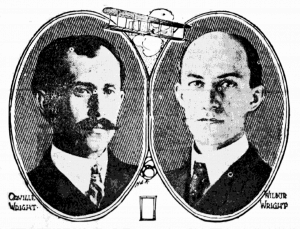
Orville and Wilbur Wright had closely followed the advances of Lilienthal and set out to achieve sustained ‘heavier than air’ flight. They struggled to produce a craft that would be light and powerful enough to achieve their objective, so hey engaged with French automobile engineers, but their lightest car engines were still too heavy. To find a solution, the brothers, who ran a bicycle repair shop in Dayton, Ohio, decided to build their own engine with the help of their friend, mechanic Charles Taylor.
READ MORE: The History of Bicycles
Their aircraft, aptly named the ‘Flyer,’ was a wood and fabric biplane 12.3m (~40ft) in length and with a wing area of 47.4 sq. meters (155 sq. feet). It had a cable system that enabled the pilot to control the height of the wings and tail, which enabled the pilot to control both the plane’s elevation and lateral movement.
So, on December 17, 1903, Orville Wright, who had ‘won’ the drawing of lots to pilot, attempted a number of flights, and his last attempt resulted in a successful flight that lasted 59 seconds and covered 260m(853ft).
The Wright brothers continued to develop their aircraft and a year later conducted the first circular flight of an engine powered airplane. Further tweaking ensued, and in 1905, the Flyer III was far more dependable than its two previous incarnations offering reliable performance and maneuverability.
A New Industry Emerges
One of the significant innovations in airplane design was introduced by Louis Blériot in 1908. The Frenchman’s Blériot VIII aircraft had a monoplane wing set up with a ‘tractor configuration.’ The tractor configuration is where the propellers of the plane are situated in front of the engine as opposed to behind, which had previously been the norm. This configuration resulted in the aircraft being pulled through the air instead of pushed, giving it superior steering.
Just a year later, Blériot made history with his latest aircraft, the Blériot XI, by crossing the English Channel, pocketing himself a £1000 prize in the process. It had been offered by the English newspaper ‘The Daily Mail’ to the first person to complete the feat.
Latest Tech Articles
Who Invented the Railroad? Exploring the Fascinating History of Railroads
Who Invented the Mechanical Reaper? History Behind the Iconic Farm Machinery
Who Invented Smartphone? Unraveling the History of Mobile Technology
While on the topic of crossing bodies of water, in September 1913, Roland Garros, also a Frenchman, flew from the South of France to Tunisia, which made him the first aviator to cross the Mediterranean.
First World War 1914 – 1918
As Europe plunged into war in 1914, the exploratory nature of airplane flight gave way to the desire to turn airplanes into machines of war. At the time, the majority of planes were biplanes, and they were used extensively for reconnaissance purposes. This was a very hazardous undertaking as ground fire would often down these relatively slow-moving airplanes.
Garros continued to play a role in the development of airplanes, but now he was focused on turning them into fighting machines. He introduced plating to the propellers of the Morane-Saulnier Type L aircraft, which provided protection when firing a gun through the propeller arc. Garros later became the first pilot to down an enemy plane using this configuration.
On the German side, at the same time, Anthony Fokker’s Company was also working on the same type of technology. They invented the synchronizer gear that enabled more reliable ordinance discharge and swung the air superiority in favor of the Germans. Garros was shot down over Germany in 1915 and was unable to destroy his plane before it fell into enemy hands. The Germans, therefore, could study the enemies technology and this complemented Fokker’s work.
Fokker’s planes gave aerial supremacy to Germany and resulted in many successful missions early in the war until the allies’ technology caught up, at which point they regained the upper hand.
Inter-War Period
In the years between the two world wars, airplane technology continued to develop. The introduction of air-cooled radial engines as opposed to water-cooled meant that engines were more reliable, lighter and with a higher power to weight ratio, meaning they could go faster. Monoplane aircraft were now very much the norm.
The first non-stop transatlantic flight was achieved in 1927 when Charles Lindbergh made the 33-hour journey from New York to Paris in his monoplane, the ‘Spirit of St Louis.’ In 1932, Amelia Earhart became the first woman to achieve this feat.
During this period, work was being carried out on rocket engines. Liquid propellant rockets were much lighter due to the liquid density and pressure required. The first manned flight with a liquid propellant rocket was completed in June 1939, a few months before the breakout of the Second World War.
Second World War 1939 – 1945
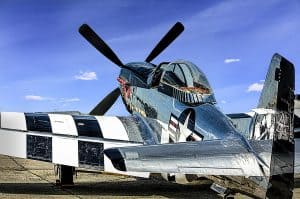
The second world war saw the airplane thrust into the forefront of military operations. The advances in design meant that there was a vast array of planes specifically suited to complete certain operations. They included fighter aircraft, bomber and attack aircraft, strategic and photo-reconnaissance aircraft, seaplanes, and transport and utility aircraft
Jet engines were a late addition to the fighter aircraft category. The mechanics behind them had been in the works for years, but the Messerschmitt Me 262, the first jet, took its inaugural flight in 1944.
The jet engine differed from the rocket engines as it drew the air in from outside the plane for the combustion process rather than the engine having to carry an oxygen supply for the job. This means jet engines have intake and exhaust openings where Rocket engines only have an exhaust.
Post War
In 1947, the rocket-engine-powered Bell X-1 became the first aircraft to break the sound barrier. The sound barrier is a point where the aerodynamic drag increases suddenly. The speed of sound is 767 mph (at 20 degrees centigrade), this had been approached in dives by airplanes with propellers, but they became very unstable. The size of the engine that would have been required to propel these planes through the sonic boom would have been impractically large.
This lead to a change in design with cone-shaped noses and sharp leading edges on the wings. The fuselage was also kept to a minimum cross-section.
As the world recovered from the ravages of war, aircraft began to be used more for commercial purposes. Early passenger planes such as the Boeing 377 and Comet has pressurized fuselages, windows and afforded flyers comfort and relative luxury not seen previously. These models were not completely polished though, and lessons were still being learned in areas such as metal fatigue. Tragically, many of these lessons were discovered after fatal failures.
The United States led the way in commercial aircraft production. Engines continued to increase in size and the pressurized fuselages got quieter and more comfortable. Advances were also achieved in navigation and general safety features around the aircraft.
As society changed in the western world, people had more disposable income, and with the expansion of air services, there were more opportunities to visit countries that were previously out of reach both financially and logistically.
The explosion in air travel and ‘vacationing’ supported many emerging businesses, some linked to expanding airports, holiday locations (hotels and attractions) and travel-related products such as many of the popular luggage brands we see today.
The Industry Expands
In the 50s and 60s, rocket technology continued to improve and space was conquered with man landing on the moon in July 1969. The Concorde, the world’s first supersonic passenger airplane, was released on the world in 1976. It could fly between New York and Paris in under four hours, but it was eventually discontinued for safety reasons.
Commercially, things started to get bigger and better. Huge aircraft, such as the Boeing 747-8 and the Airbus A380-800, meant that planes now had a capacity of more than 800 passengers.
Explore More Tech Articles
Ancient Chinese Inventions
Who Invented Paper? The History of Paper and Paper Making
Who Invented WiFi? Internet in the Air
Who Invented Calculus? A Brief History of Calculus
Who Invented Windshield Wipers? Origins of the Window Cleaning Device
Who Invented the Typewriter? A Brief History of the Typewriter and Its Numerous Inventors
Militarily, the futuristic stealth bomber emerged, and jet fighters pushed the boundaries of the possible. The F-22 Raptor is the latest in a long line of ever faster, more maneuverable, stealthier (unable to be detected by radar), and intelligent jets.
In 2018, the Virgin Galactic became the first traditional aircraft to reach the edge of space, climbing to an altitude of 270,000ft, past the 50-mile mark as defined by the US government. Today there are commercial flights that take high paying customers some 13.5 miles into the atmosphere, giving birth to a new industry: space tourism.
Conclusion
The history of the airplane is a tale of many miraculous technical advances occurring in a relatively short period. This has been driven by many brave and intellectually brilliant men and women. Most of us take for granted the accessibility we now have to worldwide destinations as a result of these pioneers, but we must never forget how truly remarkable it is that we as humans have found the ability to fly.
Bibliography
The First Hot-Air Balloon: The Greatest Moments in Flight. Tim Sharpe
Gibbs-Smith, C.H. Aviation: An Historical Survey. London, NMSI, 2008. ISBN 1 900747 52 9.
http://www.ctie.monash.edu.au/hargrave/cayley.html – The Pioneers, Aviation and Aeromodelling
Encyclopedia of World Biography – Otto Lilienthal
Encyclopedia Britannica – Louis Blériot, French Aviator. Tom D. Crouch
The First Jet Pilot: The Story of German Test Pilot Erich Warsitz – London Pen and Sword Books Ltd. 2009. Lutz Warsitz.
History of The Jet Engine. Mary Bellis.
http://www.greatachievements.org/?id=3728
NBC News – Virgin Galactic Test Flight Reaches The Edge of Space for the First Time. Dennis Romero, David Freeman and Minyvonne Burke. Dec. 13, 2018.
https://www.telegraph.co.uk/news/2016/08/03/company-offering-flights-to-the-edge-of-space-for-nearly-14000/


